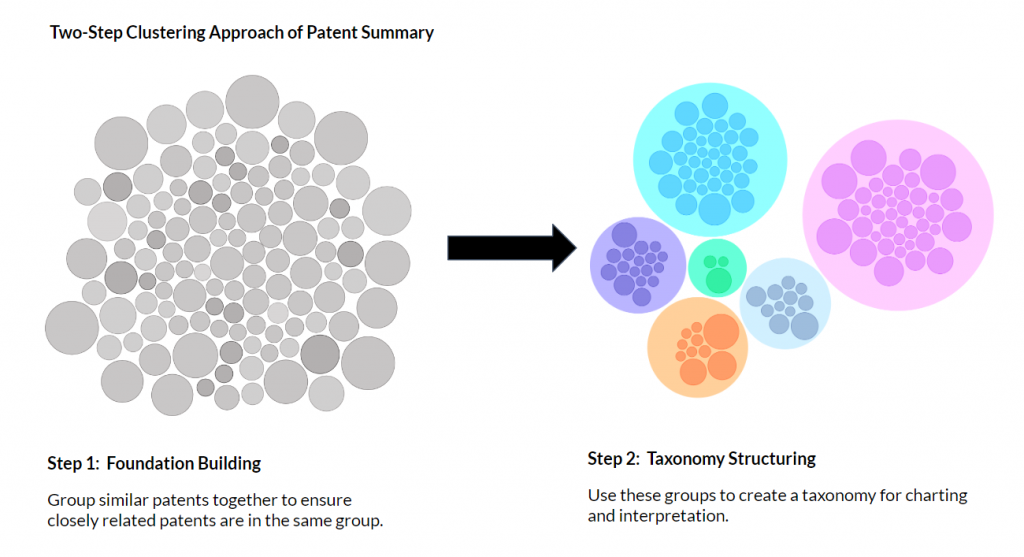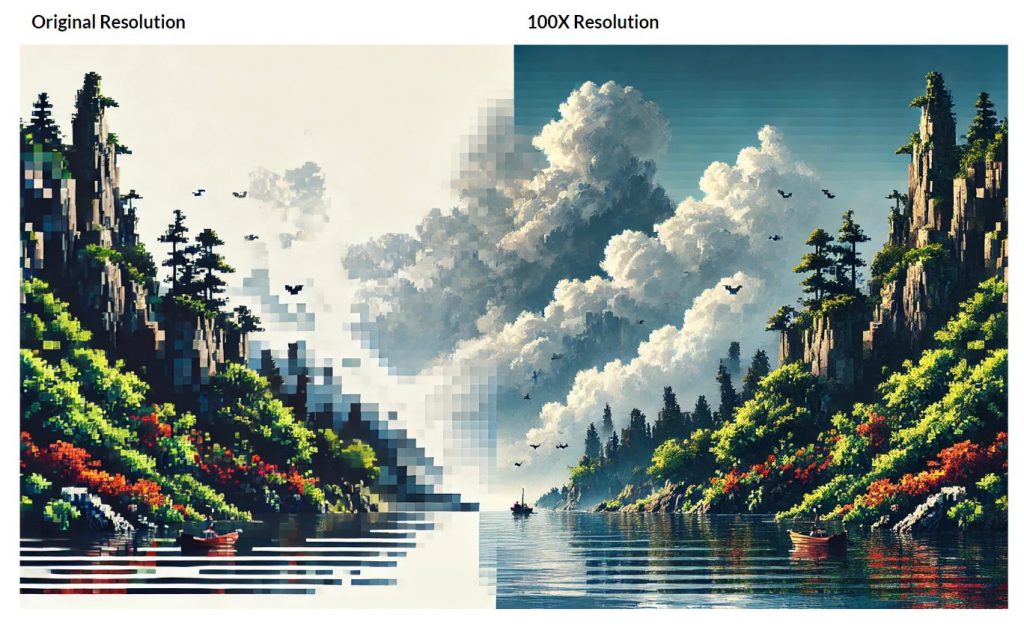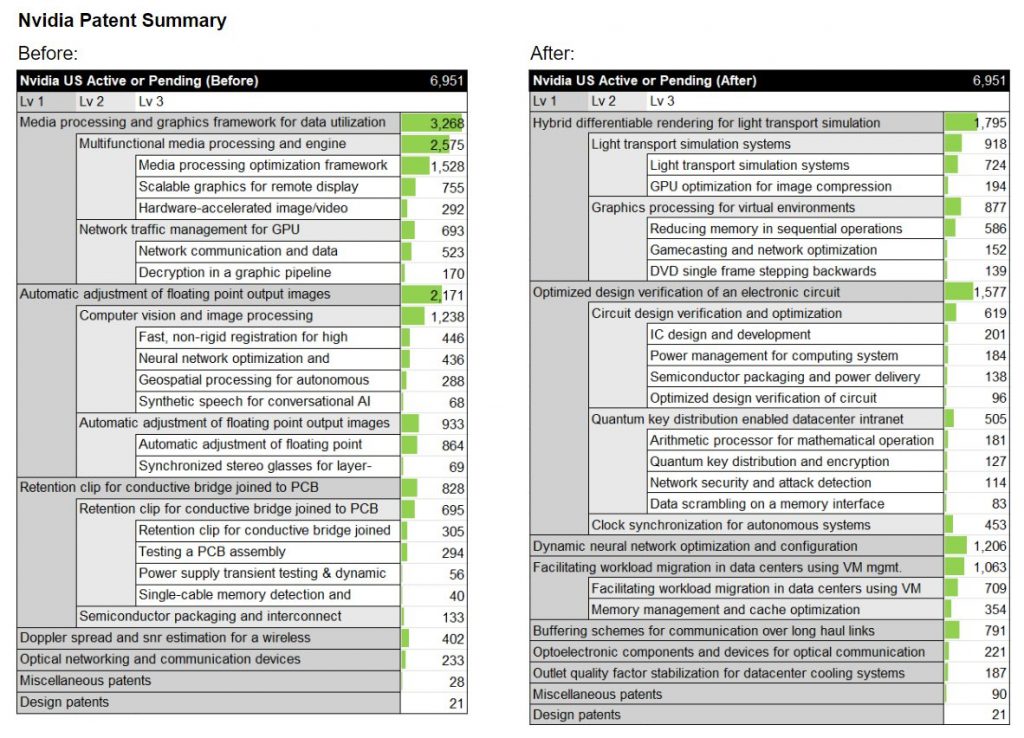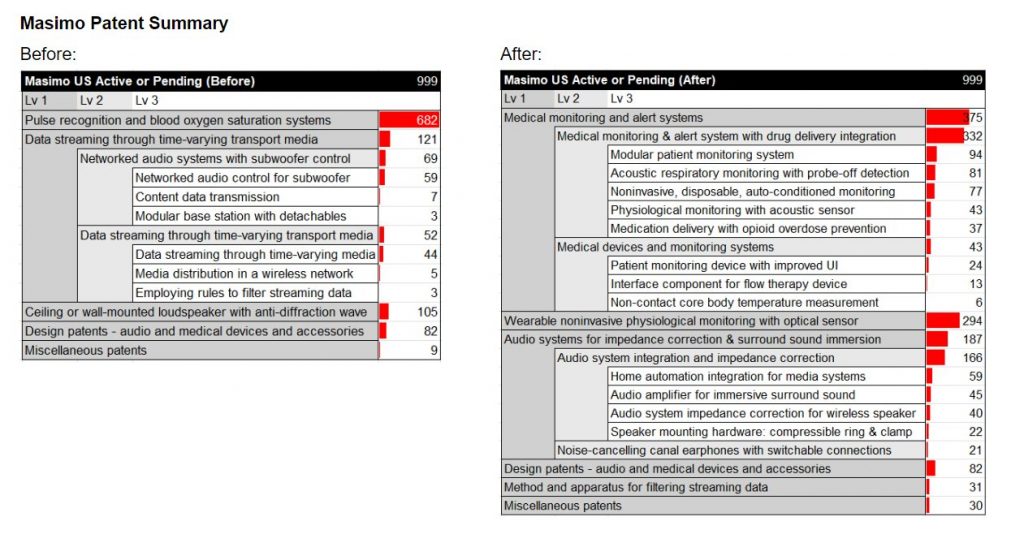Since April 2023, we have introduced the Patent Summary feature, capable of categorizing and summarizing up to 100,000 patents using our proprietary Patent Clustering technology, NLP, and generative AI. Initially integrated into our Patentcloud’s Due Diligence application, it allows users to understand the technical context behind numerical data in analysis reports, offering a comprehensive view of patent portfolios.
Table of Contents
- Transformative Impact from Generative AI: Making Patentcloud More Powerful
- The Power of 100x Resolution Enhancement
- Patent Classification Transformation: Before and After
- Discover the Difference: Try Enhanced Patent Summary
Transformative Impact from Generative AI: Making Patentcloud More Powerful
Recognizing the potential of generative AI and this feature, we realized that Patent Summary could transform the traditional linear patent search process into a breadth-first search approach. Users can continuously categorize patents, select similar categories based on summaries, and re-categorize, quickly pinpointing relevant patents from vast collections without the need for individual validation.
In October 2023, we enhanced our Quality Insights application with this feature, accelerating prior art searches and enabling users to swiftly identify the most pertinent prior art. Market feedback highlighted that Patent Summary’s automatic categorization and detailed summaries surpass traditional software relying on keyword-based detail levels. Seeing its potential for patent landscape and FTO searches, we integrated Patent Summary into our advanced Portfolio Management and Analysis product, Patent Vault, in February 2024. This integration offers automatic 1-3 layer taxonomy and matrix charts, providing clear insights into competitors’ patent strategies.
As of July 2024, we have achieved a breakthrough in the classification algorithm behind Patent Summary, further enhancing the accuracy of its categorization.
The Power of 100x Resolution Enhancement
Patent Summary operates by grouping patents based on their semantic similarity, extracting key technical content for each category, and then using generative AI to summarize these key points, with final checks done by us. Directly clustering 100,000 patents based on semantic similarity is impractical due to high computational complexity, which can lead to excessive categories and affect the usability and accuracy of the classification.
To overcome this, we adopted a two-step approach. Initially, we group patents with similar technical content into many small groups based on specific similarity criteria, a process we call “Foundation Building,” forming a highly similar foundation. Then, we further cluster these small groups based on their inter-group similarities to form the final classification, a process we call “Taxonomy Structuring,” creating a taxonomy suited for practical use cases. For example, with 100,000 patents, we might obtain thousands of small groups in the Foundation Building. After filtering out noise, we use the relationships between these small groups to create larger groups, ultimately forming 30 categories. Each category is composed of 1 to hundreds of small groups.

Figure 1: Illustration of Two-Step Clustering Approach of Patent Summary
However, the similarity criteria can introduce biases, resulting in concentration in certain categories. Users often need to further break down these concentrated categories, making the process cumbersome. To address this, our latest enhancement introduces multiple criteria during pre-processing, ensuring higher homogeneity within each group. This results in more small groups of patents for the final classification, akin to improving image recognition by increasing resolution and dimensions.

Figure 2: Impact of Resolution on Image Recognition, e.g. Higher resolution on the right clearly identifies the forest, while lower resolution on the left might mistake it for mountain peaks and cloud edges.
Specifically, this enhancement increases resolution by an average of 100 times for 100,000 patents, significantly improving accuracy. Our tests show that the miss rate for patents and their novelty prior art being in different categories is reduced by up to 50% compared to the previous version.
This breakthrough ensures clearer categorization, reducing the need for manual reclassification. Sampling from over 1,000 to nearly 100,000 patents showed 100% improvement in reducing manual reclassification needs. Users can now experience faster and more accurate patent searches, making Patent Summary an indispensable tool for patent analysis.
In the next section, we will present case studies comparing the old and new versions to demonstrate these improvements.
Patent Classification Transformation: Before and After
In this section, we will analyze the differences in patent classification before and after the enhancement, using Nvidia and Masimo as case studies. Each result will be presented with a chart showing the distribution of patent numbers, highlighting the differences.
Nvidia Patent Summary: Enhanced Granularity for Higher Accuracy
For Nvidia, a leading AI company, the previous model showed that nearly 80% of the patents were concentrated in two major categories: “media processing and graphics framework for efficient data utilization” and “automatic adjustment of floating point output images”. This required users to further explore these categories. The current model, however, splits these into four detailed categories: “hybrid differentiable rendering for light transport simulation systems and applications”, “optimized design verification of an electronic circuit”, “advanced techniques for dynamic neural network optimization and configuration”, and “facilitating workload migration in data centers using virtual machine management”.

Figure 3: Nvidia Patent Classification: Before and After, Souce: Patentcloud
This breakdown is validated by Nvidia’s patent classification, where the pairing success rate for novelty prior art in the same group improved from 77% to 86%, reducing the error rate by 40%.
Masimo Patent Summary: More Insights from Even a Small Portfolio
For Masimo, a medical device company involved in a high-profile patent litigation with Apple over the past two years, which led to the ban of some Apple products, the previous model had 682 patents (nearly 70%) under “pulse recognition and blood oxygen saturation systems and methods”. The current model further subdivides categories, particularly those focused on monitoring mechanisms.
The previous model had a 100% success rate for pairing Masimo’s patents with their novelty prior art, primarily from the largest category. The current model maintains this accuracy but distributes patents into categories with 70-90 patents each, achieving the same accuracy with much finer detail. The current model also distinguishes between optical and acoustic sensing principles more clearly.

Figure 4: Masimo Patent Classification: Before and After, Souce: Patentcloud
These case studies demonstrate how the enhanced Patent Summary feature improves granularity and accuracy, providing users with more detailed and actionable insights from the first analysis.
Discover the Difference: Try Enhanced Patent Summary
The enhanced Patent Summary feature demonstrates significant improvements in patent classification, offering greater granularity and accuracy. The case studies of Nvidia and Masimo illustrate how our advanced algorithm provides more detailed and actionable insights, even for smaller patent portfolios.
Experience these improvements firsthand. Contact us today to try the enhanced Patent Summary and see how it can transform your patent analysis process.
